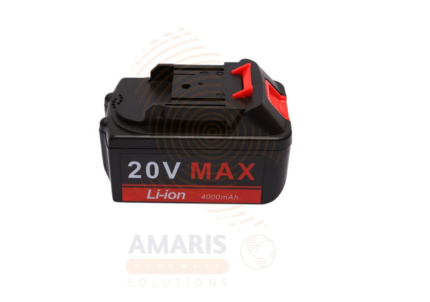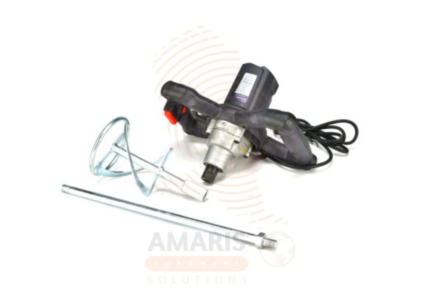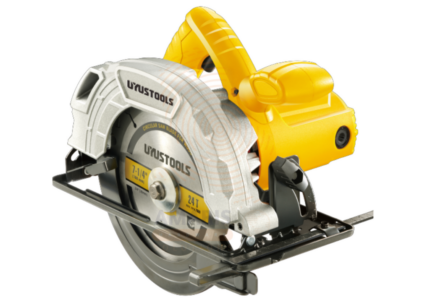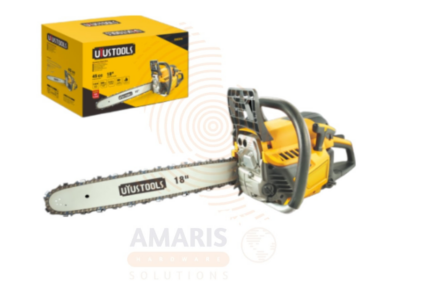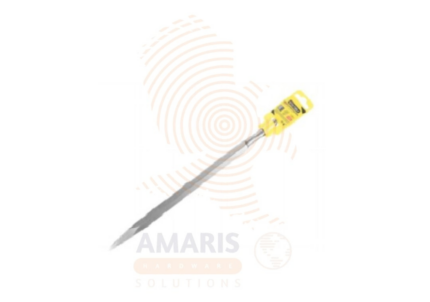
SDS Plus Stone Pointed Chisel
$14.42 Original price was: $14.42.$13.70Current price is: $13.70.

SDS Rotary Hammer Steel Set
$21.23 Original price was: $21.23.$20.17Current price is: $20.17.
SDS Rotary Hammer – 3 Operation Modes Hammering, With Rotation
$84.62 Original price was: $84.62.$80.39Current price is: $80.39.
WhatsApp Order
A SDS Rotary Hammer – 3 Operation Modes Hammering, With Rotation, is a versatile power tool designed for drilling into hard materials such as concrete, masonry, and stone. The SDS (Special Direct System) refers to the type of chuck system it uses, which allows for quick and easy changing of drill bits without the need for additional tools.
The three operation modes typically include:
- Drilling with Rotation (or Rotary Drilling): In this mode, the tool functions like a traditional drill, rotating the drill bit to bore holes into various materials.
- Hammering: In this mode, the tool delivers rapid, short, and powerful hammer blows without rotation. This is particularly effective for breaking through tough materials like concrete.
- Hammering with Rotation (or Hammer Drill): This mode combines the rotational drilling action with the hammering function, making it ideal for drilling into hard materials where both impact and rotation are necessary.
The ability to switch between these modes makes SDS Rotary Hammers suitable for a wide range of construction and renovation tasks, offering efficiency and precision in demanding applications.
Description
Table of Contents
ToggleSDS Rotary Hammer – 3 Operation Modes Hammering, With Rotation
Uses
-
Concrete Drilling:
-
With Rotation: The rotary drilling mode is ideal for drilling precise holes in concrete surfaces.
-
Hammering with Rotation: This mode is effective for drilling into tough concrete, providing both rotational force and hammering action.
-
-
Masonry Work:
-
Hammering: The hammer-only mode is useful for chiseling and breaking through masonry materials such as bricks and stone.
-
Hammering with Rotation: This mode is suitable for drilling holes in masonry, combining the impact force with rotational drilling for efficient work.
-
-
Tile and Ceramic Installation:
-
With Rotation: The rotary drilling mode can be used to drill holes in tiles or ceramics without the hammering action.
-
Hammering with Rotation: This mode is suitable for more challenging tile and ceramic installations, where the tool can penetrate hard materials.
-
-
Metal Drilling:
-
With Rotation: The rotary drilling mode is effective for drilling into metals when equipped with appropriate drill bits.
-
Hammering with Rotation: This mode can be utilized for drilling into tougher metal surfaces.
-
-
Woodworking:
-
With Rotation: The rotary drilling mode can be used for drilling into wood with the appropriate drill bits.
-
Hammering with Rotation: This mode might be employed for more challenging woodworking tasks where both impact and rotation are needed.
-
-
Anchor Installation:
-
With Rotation: The rotary drilling mode is suitable for installing anchors in various materials.
-
Hammering with Rotation: This mode can be particularly useful when dealing with hard surfaces where additional impact is required for secure anchor installation.
-
-
General Construction and Renovation:
-
-
The versatility of the SDS Rotary Hammer makes it an essential tool in construction and renovation projects, where different materials and applications may require varying drilling modes.
-
SAFETY HANDLING PRECAUTIONS
Safety Precautions
-
Protective Gear:
-
Eye Protection: Always wear safety glasses or goggles to protect your eyes from dust, debris, and any potential projectiles.
-
Hearing Protection: Use earplugs or earmuffs to safeguard your hearing, especially when working in confined spaces or for extended periods.
-
-
Personal Protective Equipment (PPE):
-
Wear appropriate clothing, including long sleeves, long pants, and sturdy work boots, to protect against potential injuries or contact with materials.
-
-
Read the Manual:
-
Familiarize yourself with the user manual provided by the manufacturer. It contains essential information on proper usage, maintenance, and safety precautions.
-
-
Secure Work Area:
-
Ensure a clean and well-lit work environment to avoid tripping hazards and improve visibility.
-
Keep bystanders and unauthorized personnel at a safe distance from the work area.
-
-
Stable Position:
-
Stand in a stable position with a firm footing. Do not overreach, and maintain balance to prevent accidental slips or falls.
-
-
Secure Material:
-
Secure the material you are working on to prevent it from moving or vibrating excessively during operation.
-
-
Chuck Inspection:
-
Before use, inspect the chuck and drill bit for any signs of wear or damage. Ensure that the chuck is securely tightened.
-
-
Correct Tool and Bit Selection:
-
Use the appropriate tool and drill bit for the material you are working on. Consult the tool manual for guidance on suitable accessories.
-
-
Switch Off When Not in Use:
-
Switch off the rotary hammer and disconnect it from the power source when not in use, during breaks, or when changing drill bits.
-
-
Power Source Safety:
-
If using a corded rotary hammer, ensure the power cord is in good condition, and use a ground fault circuit interrupter (GFCI) when working in damp or wet conditions.
-
-
Proper Grip:
-
Hold the tool with both hands, ensuring a firm and comfortable grip. This provides better control and reduces the risk of injury.
-
-
Avoid Excessive Force:
-
Let the tool do the work. Do not apply excessive force, as it can lead to loss of control and potential injury.
-
-
Ventilation:
-
Work in well-ventilated areas, especially when drilling into materials that produce dust or fumes.
-
-
Training:
-
Ensure that operators are trained on the proper use of the SDS Rotary Hammer, including the different operation modes.
-
-
Emergency Preparedness:
-
Be aware of the location of emergency exits and have a first aid kit readily available. Know how to respond in case of an emergency.
-
Related products
Bi-Metal Hole Saw Set
A Bi-Metal Hole Saw Set refers to a collection of nine hole saws, each constructed with a bi-metal design. A hole saw is a cylindrical cutting tool used to create holes in various materials such as wood, metal, plastic, and more. The term "bi-metal" indicates that the hole saws are made from two different types of metals, typically high-speed steel (HSS) and a more durable alloy like cobalt. This combination enhances the hole saw's cutting performance, making it suitable for a wide range of applications and providing increased durability and longevity. The set typically includes hole saws of different sizes to accommodate various hole diameters, making it a versatile tool for professionals and DIY enthusiasts alike.
Big Battery Pro
A " Big Battery Pro" typically refers to a rechargeable lithium-ion battery with a nominal voltage of 20 volts. The nominal voltage represents the average voltage output over the majority of the battery's discharge cycle. It's important to note that the actual voltage during use may fluctuate within a specified range.
These batteries are commonly used to power various devices, including power tools, garden equipment, and other portable electronic devices. The "20V" designation is a standardized measure indicating the electrical potential of the battery, providing a general indication of its power output.
Keep in mind that when considering a 20V battery, it's essential to verify compatibility with the specific device or tool it is intended for. Additionally, different manufacturers may have variations in the actual voltage, capacity, and features of their 20V battery products. Checking the product documentation or contacting the manufacturer for detailed specifications is recommended for accurate information.
Cement And Paint Mixer
A cement and paint mixer is a mechanical device designed to efficiently and homogeneously blend cement or paint constituents to achieve a uniform and consistent mixture. Typically utilized in construction and painting applications, these mixers come in various designs, including portable or stationary models. They feature rotating blades, paddles, or agitators that facilitate the thorough mixing of dry or liquid materials, ensuring the creation of a well-mixed and homogeneous product suitable for construction or painting purposes.
Circular Saw
A circular saw is a power tool equipped with a rotating circular blade, typically with teeth along its edge, designed for cutting various materials such as wood, plastic, metal, or masonry. It is commonly used in carpentry, construction, and other applications to make straight or beveled cuts with precision and efficiency. The circular saw is versatile and can be handheld or mounted on a table or other stationary surface, depending on the specific model and intended use.
Circular Saw Blade for Wood
A circular saw blade for wood is a cutting tool designed specifically for use with a circular saw. It typically consists of a flat, circular disc with sharp teeth along its outer edge. The blade is mounted onto the arbor of the circular saw, and as the saw operates, the blade spins rapidly to cut through wood materials. Circular saw blades for wood are specifically engineered to make efficient and clean cuts in wood, and they come in various sizes and tooth configurations to suit different cutting tasks and wood types. The teeth on the blade are strategically shaped and arranged to ensure smooth and precise cutting while minimizing splintering and tear-out on the wood surface.
Countersink Drill Set
A countersink drill set typically refers to a collection of six tools designed for countersinking operations in woodworking or metalworking. Each set usually includes six individual countersink drills with varying sizes or angles. Countersinking is a process that involves creating a conical hole in a material, allowing the head of a screw or bolt to sit flush with or below the surface. These drill sets are essential for achieving a professional finish in various applications where a smooth and even surface is desired, such as in carpentry, metal fabrication, or DIY projects.
Gasoline Chain Saw
A Gasoline Chain Saw is a portable, mechanical cutting tool powered by an internal combustion engine that runs on gasoline. It typically consists of a chain with teeth attached to a guide bar, driven by the engine, and is commonly used for tasks such as tree felling, limb pruning, and wood cutting. The gasoline engine provides the necessary power to drive the chain, making the chainsaw a versatile tool for various outdoor cutting applications.
Glass Drill Set Hexagonal Handle
A Glass Drill Set Hexagonal Handle typically refers to a collection of five drill bits specifically designed for drilling holes in glass surfaces. The term "hexagonal handle" indicates that the shank of each drill bit has a hexagonal (six-sided) shape, which can provide a better grip and prevent slipping when used with a compatible drill. These drill bits are specifically crafted for working with glass materials, offering precision and minimizing the risk of cracking or damaging the glass during the drilling process. The set may include different-sized bits to accommodate various hole diameters.


 Acrylic Sealants
Acrylic Sealants Construction Adhesives
Construction Adhesives Double-Sided Tape
Double-Sided Tape Duct Tape
Duct Tape Electrical Tape
Electrical Tape Epoxy & Resins
Epoxy & Resins Masking Tape
Masking Tape
 Automotive Wrenches & Socket Sets
Automotive Wrenches & Socket Sets Battery Chargers & Jump Starters
Battery Chargers & Jump Starters Car Jacks & Stands
Car Jacks & Stands Car Wash & Detailing Products
Car Wash & Detailing Products Diagnostic Tools
Diagnostic Tools Tire Inflators
Tire Inflators Vehicle Lighting
Vehicle Lighting Oil & Lubricants
Oil & Lubricants
 Adhesives & Sealants
Adhesives & Sealants Bricks & Blocks
Bricks & Blocks Cement & Concrete
Cement & Concrete Drywall & Plaster
Drywall & Plaster Flooring (Tiles, Wood, Laminate)
Flooring (Tiles, Wood, Laminate) Lumber & Plywood
Lumber & Plywood Paints, Primers & Coatings
Paints, Primers & Coatings Insulation Materials
Insulation Materials Roofing Materials
Roofing Materials
 Circuit Breakers
Circuit Breakers Electrical Cables & Wires
Electrical Cables & Wires Switches & Sockets
Switches & Sockets Fuses & Relays
Fuses & Relays Connectors & Terminals
Connectors & Terminals Electrical Boxes & Panels
Electrical Boxes & Panels Conduit & Fittings
Conduit & Fittings Lighting Fixtures & Bulbs
Lighting Fixtures & Bulbs Extension Cords & Power Strips
Extension Cords & Power Strips
 Anchors
Anchors Bolts
Bolts Clips & Clamps
Clips & Clamps Screws
Screws Nuts
Nuts Washers
Washers Rivets
Rivets Nails
Nails Threaded Rods
Threaded Rods
 Hammers
Hammers Measuring Tools (Tapes, Levels, Calipers)
Measuring Tools (Tapes, Levels, Calipers) Screwdrivers
Screwdrivers Pliers & Cutters
Pliers & Cutters Saws & Blades
Saws & Blades Chisels & Punches
Chisels & Punches Allen Keys & Hex Keys
Allen Keys & Hex Keys Ratchets & Socket Sets
Ratchets & Socket Sets Wrenches & Spanners
Wrenches & Spanners
 Power Tool Accessories (Blades, Bits, Discs)
Power Tool Accessories (Blades, Bits, Discs) Rotary Tools
Rotary Tools Saws (Circular, Jigsaw, Reciprocating)
Saws (Circular, Jigsaw, Reciprocating) Drills & Drivers
Drills & Drivers Grinders & Sanders
Grinders & Sanders Heat Guns
Heat Guns Nail Guns
Nail Guns Impact Wrenches
Impact Wrenches Batteries & Chargers
Batteries & Chargers
 Pipes & Fittings (PVC, Copper, PEX)
Pipes & Fittings (PVC, Copper, PEX) Plumbing Tools
Plumbing Tools Pumps & Motors
Pumps & Motors Sealants & Adhesives for Plumbing
Sealants & Adhesives for Plumbing Valves & Taps
Valves & Taps Water Heaters
Water Heaters Drainage Systems
Drainage Systems Faucets & Fixtures
Faucets & Fixtures Hoses & Tubing
Hoses & Tubing
 Hinges & Latches
Hinges & Latches Hooks & Brackets
Hooks & Brackets Window Hardware
Window Hardware Chains & Cables
Chains & Cables Casters & Wheels
Casters & Wheels Shelving & Storage Systems
Shelving & Storage Systems Door Handles & Locks
Door Handles & Locks Drawer Slides & Cabinet Hardware
Drawer Slides & Cabinet Hardware
 Personal Protective Equipment (PPE)
Personal Protective Equipment (PPE) Respirators & Masks
Respirators & Masks Safety Glasses
Safety Glasses Safes
Safes Security Cameras
Security Cameras Gloves
Gloves Helmets
Helmets Ear Protection
Ear Protection Fire Safety Equipment
Fire Safety Equipment Locks & Padlocks
Locks & Padlocks Motion Sensors & Alarms
Motion Sensors & Alarms
 Garden Fencing
Garden Fencing Garden Furniture Hardware
Garden Furniture Hardware Lawn Mowers
Lawn Mowers Trimmers & Edgers
Trimmers & Edgers Shovels & Spades
Shovels & Spades Rakes & Hoes
Rakes & Hoes Pruning Shears & Loppers
Pruning Shears & Loppers Watering Systems (Hoses, Sprinklers, Nozzles)
Watering Systems (Hoses, Sprinklers, Nozzles)
 Interior Paints
Interior Paints Paint Brushes & Rollers
Paint Brushes & Rollers Paint Strippers & Thinners
Paint Strippers & Thinners Paint Trays & Accessories
Paint Trays & Accessories Exterior Paints
Exterior Paints Spray Paints
Spray Paints Primers & Undercoats
Primers & Undercoats Varnishes & Stains
Varnishes & Stains
 Gaskets & Seals
Gaskets & Seals Hydraulic Fittings
Hydraulic Fittings Industrial Fasteners
Industrial Fasteners Industrial Hoses
Industrial Hoses Lubricants & Greases
Lubricants & Greases Metal Sheets & Bars
Metal Sheets & Bars Bearings & Bushings
Bearings & Bushings Belts & Pulleys
Belts & Pulleys
 HVAC Filters
HVAC Filters Insulation for HVAC
Insulation for HVAC Air Conditioners
Air Conditioners Refrigerants
Refrigerants Ventilation Ducts & Fittings
Ventilation Ducts & Fittings Thermostats & Controllers
Thermostats & Controllers Fans & Blowers
Fans & Blowers
 Pegboards & Hooks
Pegboards & Hooks Shelving Units
Shelving Units Storage Bins & Containers
Storage Bins & Containers Toolboxes & Tool Chests
Toolboxes & Tool Chests Workbenches
Workbenches Drawer Organizers
Drawer Organizers Labeling Supplies
Labeling Supplies
 Welding Accessories (Clamps, Brushes)
Welding Accessories (Clamps, Brushes) Welding Electrodes & Rods
Welding Electrodes & Rods Welding Helmets & Gloves
Welding Helmets & Gloves Welding Machines
Welding Machines Soldering Irons & Stations
Soldering Irons & Stations Flux & Solder Wire
Flux & Solder Wire
 Generator Accessories
Generator Accessories Inverters
Inverters Portable Generators
Portable Generators Power Inverters
Power Inverters Transfer Switches
Transfer Switches Diesel & Gasoline Generators
Diesel & Gasoline Generators
 Transport Equipment: Carts, Dollies, and Hand Trucks
Transport Equipment: Carts, Dollies, and Hand Trucks Storage Solutions: Pallets, Racks, and Containers
Storage Solutions: Pallets, Racks, and Containers Lifting Equipment: Hoists, Cranes, and Jacks
Lifting Equipment: Hoists, Cranes, and Jacks Conveyors and Accessories: Belts and Rollers
Conveyors and Accessories: Belts and Rollers

